Show in Contents

Add to Favorites

Home: Autodesk Maya Online Help

Create or import nCaches

nCaching

Rename nCaches

Work with nCache clips
In the Trax
Editor, nCache nodes are represented by nCache
clips. With these cache clips, you can clearly view the
relationships between your nCaches and edit your cached simulations
in a nonlinear manner. This allows you to visually manage, manipulate,
and direct all your objects’ caches at the same time.
NotenCloth caches only
store the XYZ positions of an nCloth object’s vertices, not
the translation, rotation, or scale of the nCloth’s Transform node.
To view nCache clips
- Before you can view your object’s cache clips,
you first need to cache your object’s simulation. See
Create or import nCaches.
- In the scene view, select the Nucleus
or fluid object for which you want to view cached clips.
- Open the Trax Editor (Window
> Animation Editors > Trax Editor).
- In the Trax Editor menu
bar, select List > Load Selected Characters.
All the selected object’s
cache nodes are loaded into the Trax Editor as
cache clips. Each clip is placed on its own track, and all your
object’s cache clips are grouped under your object’s cache label:
outputCloth for nCloth caches, nParticleShape for nParticle caches,
and fluidShape for fluid caches.
To
select your object from Trax
- In the Trax Editor,
select the nCache clip for the object you want to select in your
scene.
- In the track view,
 -click
the cache clip and choose Select Geometry from
the context-sensitive menu that appears.
-click
the cache clip and choose Select Geometry from
the context-sensitive menu that appears.
The cache clip’s object
is now selected in your scene.
To
move nCache clips
- In the scene view, select the object
whose cache clip you want to move.
- In the Trax Editor,
select List > Load Selected Characters.
All the current object’s
caches appear as clips in the track view.
- Do the following:
- To move your nCache clip forward or backward
in time, drag the cache clip from side to side.
- To move your nCache clip to a different
track, drag the cache clip upward or downward.
To move multiple nCache clips in time
- In the scene view, select the object
whose cache clips you want to move.
- In the Trax Editor,
select List > Load Selected Characters.
All the current object’s
caches appear as clips in the track view.
-
 -
-  the
cache clips you want to move.
the
cache clips you want to move.
The nCache clip manipulator
appears.
- Drag the translate handle to the left
or right to move all the selected cache clips at the same time.
The selected cache clips
move forward or backward in time, changing their Start
Frame values.
To move all of an object’s nCache clips
in time
- In the scene view, select the object
whose cache clips you want to move.
- In the Trax Editor,
select List > Load Selected Characters.
All the current objects’s
caches appear as clips in the track view.
- Drag the object’s summary cache clip
to the left or right.
All your object’s cache
clips move forward or backward in time, changing the Start
Frame of all your object’s cache clips.
Lock, solo, or mute nCache
tracks
To lock an nCache track
- In the scene view, select the object
whose nCache clip track you want to lock.
- In the Trax Editor,
select List > Load Selected Characters.
All the current object’s
caches appear as clips in the track view.
- In the track control area, click the Lock button
to the left of the nCache track you want to lock.
The Lock button
freezes the nCache track. When a track is locked, you can not edit
its cache clips, but its cached simulation is present during playback.
You can lock an nCache track so that you do not accidentally modify
its cache clips.
To solo an nCache track
- In the scene view, select the object
whose nCache clip track you want to solo.
- In the Trax Editor,
select List > Load Selected Characters.
All the current nCaches
appear as clips in the track view.
- In the track control area, click the Solo button
to the left of the nCache track you want to solo.
The Solo button
isolates the nCache clips on the selected track so that they are
the only caches used during playback. Soloing is useful when you
want to isolate and review the effect of a specific track’s cache
on your simulation.
To mute an nCache track
- In the scene view, select the object
whose nCache clip track you want to mute.
- In the Trax Editor,
select List > Load Selected Characters.
All the current object’s
caches appear as clips in the track view.
- In the track control area, click the Mute button
to the left of the nCache track you want to mute.
The Mute button
hides the cached simulation of a selected track without removing
that track from the Trax Editor. Muting is useful
when you want to view a simulation without the effect of a certain
track’s cache.
NoteChanging the names
of geometry cache nodes in the Attribute Editor or Channel Box also
changes the names of their corresponding geometry cache clips in
the Trax Editor.
Enable or disable nCache
clips
NoteEnabling or disabling
nCache clips also enables or disables their corresponding cache
nodes and Attribute Editor tabs.
To enable or disable individual nCache clips
- In the scene view, select the object
whose cache clip you want to enable or disable.
- In the Trax Editor,
select List > Load Selected Characters.
All the current object’s
caches appear as clips in the track view.
- Select the nCache clip you want to enable
or disable.
- Do one of the following:
- In the track view,
 -click
the selected cache clip. In the context-sensitive menu that appears,
turn on Enable to make your cache clip
active or turn off Enable to make your cache clip
inactive.
-click
the selected cache clip. In the context-sensitive menu that appears,
turn on Enable to make your cache clip
active or turn off Enable to make your cache clip
inactive.
- In the Trax menu bar, select Modify
> Enable/Disable to make the selected cache clip active
or inactive, depending on its current state.
Enable or disable all of
an object’s nCache clips
You can enable or disable
all of an object’s nCache clips by enabling or disabling the object’s
nCache. See the procedure below.
To disable all of
an object’s nCaches
- Select the object for which you want
to disable all of its caches.
- Depending on the object type, do one
of the following:
All your current object’s
active cache nodes and cache clips are disabled and are now not used
by their object on playback.
To enable all of
an object’s nCaches
- Select the object for which you want
to enable all of its caches.
- Depending on the object type, do one
of the following:
All your current object’s
inactive cache nodes and cache clips are enabled and are now used
by their object on playback.
To enable or disable individual nCaches
- Select the nCloth object for which you
want to enable or disable individual caches.
- In the Attribute Editor,
select the tab for the nCache you want to enable or disable.
- In the Cache File section,
do one of the following:
- Turn Enable on
to activate the cache.
The nCache node and its
corresponding cache clip become active and are now used by their
object on playback.
- Turn Enable off
to deactivate the cache.
The nCache node and its
corresponding cache clip become inactive and are now not used
by their object on playback.
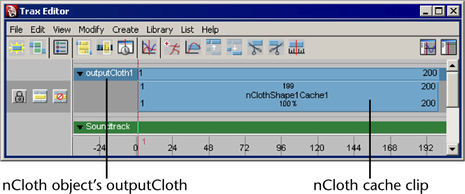
 -click
the cache clip and choose Select Geometry from
the context-sensitive menu that appears.
-click
the cache clip and choose Select Geometry from
the context-sensitive menu that appears.
 -
-  the
cache clips you want to move.
the
cache clips you want to move.
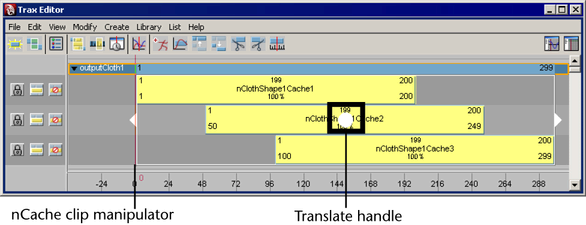

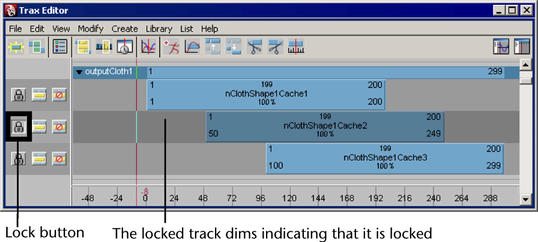
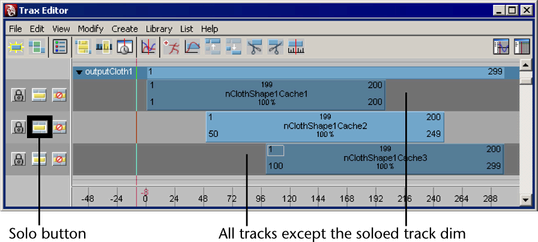
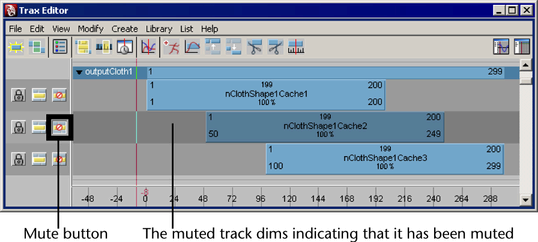
 -click
the selected cache clip. In the context-sensitive menu that appears,
turn on Enable to make your cache clip
active or turn off Enable to make your cache clip
inactive.
-click
the selected cache clip. In the context-sensitive menu that appears,
turn on Enable to make your cache clip
active or turn off Enable to make your cache clip
inactive.
